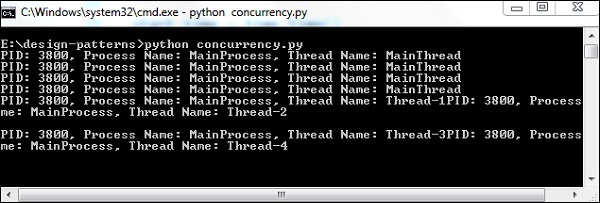Python並行(多執行緒)
並行性常常被誤解為並行性。 並行意味著排程獨立程式碼以系統方式執行。 本章重點介紹使用Python的作業系統的並行執行。
以下程式實現執行作業系統的並行性 -
import os
import time
import threading
import multiprocessing
NUM_WORKERS = 4
def only_sleep():
print("PID: %s, Process Name: %s, Thread Name: %s" % (
os.getpid(),
multiprocessing.current_process().name,
threading.current_thread().name)
)
time.sleep(1)
def crunch_numbers():
print("PID: %s, Process Name: %s, Thread Name: %s" % (
os.getpid(),
multiprocessing.current_process().name,
threading.current_thread().name)
)
x = 0
while x < 10000000:
x += 1
for _ in range(NUM_WORKERS):
only_sleep()
end_time = time.time()
print("Serial time=", end_time - start_time)
# Run tasks using threads
start_time = time.time()
threads = [threading.Thread(target=only_sleep) for _ in range(NUM_WORKERS)]
[thread.start() for thread in threads]
[thread.join() for thread in threads]
end_time = time.time()
print("Threads time=", end_time - start_time)
# Run tasks using processes
start_time = time.time()
processes = [multiprocessing.Process(target=only_sleep()) for _ in range(NUM_WORKERS)]
[process.start() for process in processes]
[process.join() for process in processes]
end_time = time.time()
print("Parallel time=", end_time - start_time)
執行上述程式生成以下輸出 -
說明multiprocessing是一個類似於執行緒模組的包。 該軟體包支援本地和遠端並行。 由於這個模組,程式員可以在給定的系統上使用多個進程。